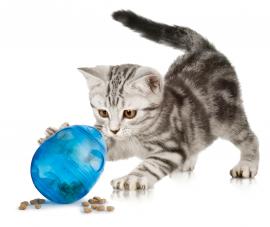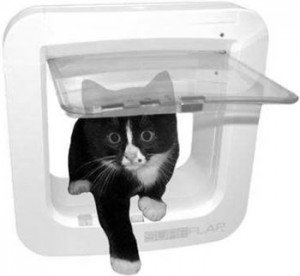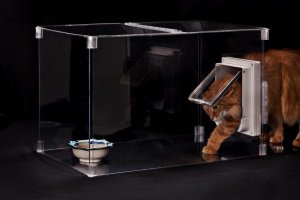A simple guide to feeding your cat
Mealtime is a special time for cats.
Feeding not only satisfies a cat’s abundant energy needs, but also provides her with the right nutrients she needs to stay healthy and strong. Although some cats have the ability to regulate their food intake, others will overindulge or have difficulty eating around other cats. Inside this guide, you’ll find helpful tips and suggestions to help you understand your cat’s unique feeding behavior and how to properly feed her for the best possible results.
Natural feeding behavior of cats
 Cats are solitary hunters and eaters. Among all cat species, only lions hunt and eat together. In a natural setting, cats will hunt and eat 10 or more small meals per day. One way to mimic this natural hunting behavior is to use a ‘foraging feeder’ or ‘food puzzle’ where your cat has to interact with the feeder to get small pieces of food (e.g., Slim cat ball, Egg-cersizer, etc.) You can also hide small amounts of dry food around the house for your cat to seek out and eat, perhaps in shallow plastic containers or egg cartons.
Cats are solitary hunters and eaters. Among all cat species, only lions hunt and eat together. In a natural setting, cats will hunt and eat 10 or more small meals per day. One way to mimic this natural hunting behavior is to use a ‘foraging feeder’ or ‘food puzzle’ where your cat has to interact with the feeder to get small pieces of food (e.g., Slim cat ball, Egg-cersizer, etc.) You can also hide small amounts of dry food around the house for your cat to seek out and eat, perhaps in shallow plastic containers or egg cartons.
For people, eating is a social event, but because cats are solitary hunters, most would prefer to eat alone. This means when one cat in a home must be fed separately from the others, she is probably happier. Although they prefer to eat alone, healthy cats may not mind the presence of others at feeding time. However, in times of illness or stress, this tolerance may decrease. It is also important to know that the behaviors shown by your cat when you come home (e.g., meowing, rubbing on your legs, seeking attention) is a greeting behavior and is not a request for food. You should reward this behavior with attention such as petting or play, but feed your cat later.
Temperature matters
As a hunter, cats prefer food that is close to their own body temperature (about 101° F/ 38° C). If you are taking canned food from the refrigerator, it should be warmed in the microwave (and stirred well) or warmed by the addition of some hot water.
Feeding behavior – dogs vs. cats
| Cat | Dog |
| Strict carnivore (must have animal source protein in their diet, but also able to use many nutrients from plants) | Omnivore (diet of plant and animal sources) |
| 10 or more small meals/day | 1-3 larger meals/day |
| Will hunt and eat at any time of day or night | Hunt and eat during daylight |
| No social value to eating | Eating has social value |
Simple guidelines for feeding
- Feeding (food and water), sleeping/resting, and litter box areas should be separate from each other
- Ideally each cat should have its own food and water ‘station’, preferably in a quiet, low traffic place where the cat likes to spend time
- Water bowls should be wide and shallow; water should be fresh daily; some cats prefer to drink from a dripping faucet or a water fountain
- Many cats eat more readily from shallow bowls or plates so their whiskers don’t touch the sides
- Ideally, place food and water bowls separate from each other
- Food and water dishes should be kept clean
- Measure the food allotment for each cat according to the amount recommended by your veterinarian; monitor daily food intake and appetite
Feeding Multiple Cats
Cats are solitary feeders, so when there are multiple cats in the home, it can be difficult to know how and when to feed each cat.
Here are three common ways to feed:
Finding the right feeding plan
| Method | Availability | Advantages | Disadvantages |
| Meal feeding |
Food is provided at specific meal times (often 2 to 4 times) during the day but is not freely available between meals; both canned and dry foods can be fed in this manner. |
• Food intake can be closely monitored• Easy to tell if a cat has a poor appetite• All cats have access to food |
• Must avoid allowing the cat to beg for food between meals• The cat cannot control when it eats |
| Free choice feeding |
Food is available at all times; only dry foods can be fed in this way. |
• Allows the cat to eat multiple small meals per day on its own schedule |
• It is difficult to monitor how much each cat• More difficult to tell if a cat has a poor appetite• Often leads to overeating and obesity; consider using a food puzzle or forage feeder with a measured amount of dry food to prevent overfeeding |
| Combination feeding |
Canned food is fed as a meal, often twice daily, and dry food is freely available. |
• Allows the cat to eat multiple small meals per day on its own schedule• Intake of canned food can be monitored• Appetite can be partially monitored |
• Total food intake is not easily monitored• Often leads to overeating and obesity; consider using a food puzzle or forage feeder with a measured amount of dry food to prevent overfeeding |
The type of feeding plan you choose will depend on many factors, such as the number of cats in your home, and the age and health status of your cats. Your veterinarian can help you decide which method is most appropriate.
Generally in most multi-cat homes, meal feeding with individual feeding stations is the best approach. This is especially true when some cats must be fed a specific type of food. Free choice feeding can be problematic in multi-cat situations, particularly because it is not easy to monitor each cat’s appetite and food intake. This can make it more difficult to tell when your cat is not feeling well.
Additionally, assertive cats may block access to the food bowls and guard it from shyer cats, or make shyer cats leave the food bowl before they are finished eating. Conflict among cats is often subtle — cats communicate largely by eye contact, facial expression and body language.
Setting up a feeding station
Each cat can be fed in a separate room in the home with the door closed. Typically, a regular feeding schedule is used, and each cat is given a certain amount of time to eat (e.g., 20 to 30 minutes). Water is freely available in several places at all times.
There are ways that overweight cats can be fed separately from their slimmer housemates. For example, a hook and eye closure can be put on the door to one room to allow the door to remain open enough so that the slim cat can fit through, but not the overweight cat. Or the slim cat can be fed on a high surface, such as a shelf or counter, where the overweight cat is unable to jump up. It may also be possible to use a baby gate to feed cats in separate rooms if the overweight cat cannot jump over the barrier.
 Feeding stations can be homemade using a plastic storage box and a cat flap operated by your cat’s own microchip (e.g., SureFlap®). Commercial feeding stations are also available (e.g., MeowSpace®). Food can be freely available in the feeding station if recommended by your veterinarian, or a meal-feeding plan can be used. Another option is to use a timed feeder inside the feeding station.
Feeding stations can be homemade using a plastic storage box and a cat flap operated by your cat’s own microchip (e.g., SureFlap®). Commercial feeding stations are also available (e.g., MeowSpace®). Food can be freely available in the feeding station if recommended by your veterinarian, or a meal-feeding plan can be used. Another option is to use a timed feeder inside the feeding station.
Regardless of the feeding plan that is chosen, it is important to consult your veterinarian about the amount of calories your cat should consume each day. If a free choice or combination feeding plan is used in a multi-cat home, it is important that the volume of food offered should not exceed the total calorie requirements for all the cats each day.
 Feed most of the daily food allotment when family members are at home. This will reduce the chance your cat will learn to beg for food. Full bowls of food should not be available when no one is at home.
Feed most of the daily food allotment when family members are at home. This will reduce the chance your cat will learn to beg for food. Full bowls of food should not be available when no one is at home.
Changing to a new food
Dietary changes are made for many reasons, such as the need to control weight or to manage a health risk or condition. If your cat has been ill and now requires a new food, it is important to wait until she is feeling well, eating her usual food, and is home from the hospital before attempting the change.
If your cat has previously been fed by the free choice method, this can be a good time to change to meal feeding as she is more likely to be hungry at feeding time and try the new food.
Tips
- Leave each meal of the new food out for no more than 1 hour at a time.
- Offer the new food in a familiar food bowl side by side with her usual food. Many cats will readily eat the new food within a few days, but others may take a week or longer (sometimes up to 6 weeks), so it pays to be patient.
- Once she is eating the new food every day, you can start to decrease the amount of the old food that is available by 25% each day until the change is complete.
- Make sure you know the minimum amount of food your cat should eat each day, and contact your veterinarian for advice if she is eating less than the recommended amount.
Contributions by Susan Little, DVM, DABVP (Feline)
Tampa, FL 33615 (View map)
Tampa, FL 33647 (View map)
Tampa, FL 33617 (View map)
Tampa, FL 33647 (View map)








